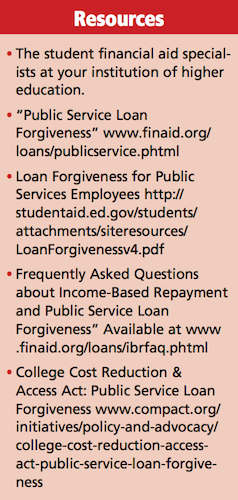Student Loan Forgiveness: Pharmacist's Public Service Positions Can Help
Government programs can assist with student loan repayment.

Government programs can assist with student loan repayment.
If you’re like many pharmacists these days, you may have entered the profession with the burden of substantial student loan repayment obligations. Some graduates estimate that this burden will approach $100,000 by the time they walk across the commencement stage. This figure takes into account debt commitments from both pre-professional and professional academic work.
While pharmacists are currently enjoying substantial levels of compensation across the nation, not all positions for pharmacists feature the generous salaries others do. Positions that are very professionally rewarding with governmental or other nonprofit entities sometimes do not offer top-level salaries. Congress has attempted to address this by providing some incentive for graduates to assume these lower-salary positions, which are professionally essential for serving the public—and have graduates continue in them for a number of years.
Eligibility for Loan Forgiveness
During 2007, Congress enacted the College Cost Reduction and Access Act.1 That legislation included the Public Service Loan Forgiveness Program, a provision authorizing the US Department of Education to extend loan forgiveness, both principal and interest, for students who used Direct Loans, including Direct Stafford, PLUS, or Consolidation Loans, for financing their education and then moved into public service positions upon graduation. This program is available to loan holders who meet several criteria:
- Have made 120 monthly payments on a Direct Loan after October 1, 2007, as part of an income contingent repayment plan or a standard repayment plan based on a 10-year repayment schedule
- Are employed in a "public service job" and have been employed in a public service job during the 120-payment period.
- Qualified pharmacists may be eligible for forgiveness of the remaining balance due on their eligible federal student loans.
While nearly all pharmacy positions could be deserving of the designation “public service,” Congress needed to define that phrase for purposes of this legislation. As used in this statute, “public service” includes:
(i) A full-time job in emergency management, government, military service, public safety, law enforcement, public health, public education (including early childhood education), social work in a public child or family service agency, public interest law services (including prosecution or public defense or legal advocacy in low-income communities at a non-profit organization), public child care, public service for individuals with disabilities, public service for the elderly, public library sciences, school-based library sciences and other school-based services, or at an organization that is described in section 501(c)(3) of the Internal Revenue Code of 1986 and exempt from taxation under section 501(a) of such Code; or (ii) Teaching as a full-time faculty member at a Tribal College or University and other faculty teaching in high-need areas, as determined by the administering federal agency.2 (Emphasis added.)
Pharmacy Jobs
Examples of positions for pharmacists that may well qualify for this program include:
- Working for a government agency such as the US Food and Drug Administration or a state board of pharmacy;
- Serving as a pharmacist in one of the branches of the US military or with the Veterans Administration;
- Working for the US Drug Enforcement Administration or a state-level law enforcement agency related to controlled substances; and
- Practicing with the US Public Health Service or a state or local public health department.
One observer has concluded that nearly all governmental positions will qualify the individual for participation in this program.3 Whether a specific individual will meet the qualification criteria—for example, outstanding student loan obligations are in the eligible categories—needs to be determined.
Given the level of existing educational program debt some pharmacists had upon graduation, they may feel compelled to seek out and accept the position offering the highest salary, even if it may be less professionally challenging or rewarding in a non-monetary sense than other opportunities.
One note of caution—when the time comes to avail yourself of the benefits of this program, you likely will no longer be affiliated with your institution of higher education and its Office of Student Financial Aid. This is so because of the requirement that the loan forgiveness is available following 10 years of monthly payments on the loan balance. For more information about the many and varied facets of this complex legislative program, the resources listed in the side bar provide detailed information.

So, this federal legislation may free you up to give serious consideration to that professionally challenging and rewarding position with a nonprofit employer. While it requires that the pharmacist works in a particular sector of the economy—the nonprofit sector—it does not require that one always work for the same employer. And if that means you can work in the position you find most personally fulfilling, then the words of the old quotation attributed to Confucius will apply—“Find a job you love and you’ll never work a day in your life.”
Dr. Fink is professor of pharmacy law and policy and Kentucky Pharmacists Association Endowed Professor of Leadership at the University of Kentucky College of Pharmacy, Lexington.
References:
- Pub. L. No. 110-84, 121 Stat. 784 (2007). http://www.gpo.gov/fdsys/pkg/PLAW-110publ84/pdf/PLAW-110publ84.pdf
- §401 of the Act. 121 Stat. at 801 codified at 20 U.S.C. §1087e(m)(3)(B).
- Schrag PG. Federal student loan repayment assistance for public interest lawyers and other employees of governments and nonprofit organizations. 36 Hofstra L Rev. 27, at 46. (2007). http://www.law.washington.edu/finaid/docs/FederalLRAP.pdf.

